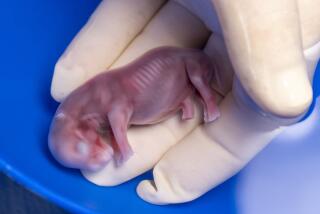Extinct species of gibbon discovered in an unlikely place — the tomb of a Chinese noblewoman
In the tomb of the grandmother of an ancient Chinese emperor, an international team of scientists has discovered the skull of a species of gibbon that looks unlike any gibbon alive today.
The ape, Junzi imperialis, described in Friday’s edition of the journal Science, may represent the earliest documented ape extinction since the last ice age — and could be the first known to go extinct because of human influence.
“The Junzi find is a sobering lesson in the devastating effects that humans can have on the natural world,” senior author Helen Chatterjee, an evolutionary biologist at University College London, said in an email. “Human exploitation of nature (such as gibbons) and habitat destruction are causing extinction rates to escalate beyond all natural levels and at exponential rates.”
The discovery also could shed light on the threat to the survival of gibbons today, the scientists said.
“Our description of J. imperialis suggests that past human-caused primate diversity loss may be underestimated,” the study authors wrote, “with important implications for understanding extinction vulnerability and informing conservation.”
The gibbon’s partial skull and teeth come from a tomb in Xi’an, where the ancient capital Chang’an once stood. It’s thought to be roughly 2,250 years old and may hold Lady Xia, the grandmother of China’s first emperor, Qin Shi Huang, who brought the many warring states of China under unified rule (and who was buried in an enormous mausoleum containing the famous terra cotta army).
The tomb, which was originally discovered in 2004, also held pits containing a menagerie of animals, including the bones of a leopard, lynx, Asiatic black bear, crane, domestic mammals and birds — and a gibbon.
Gibbons are long-armed, tree-dwelling primates that are much smaller than the great apes (such as gorillas, orangutans and humans). Today, they’re under threat because of human-caused pressures, Chatterjee said: Of the 20 living gibbon species, all but one are endangered, some critically, because of deforestation, fire, hunting and poaching, among other threats.
In ancient China, gibbons held a special place among primates in the eyes of humans, the scientists said.
“Gibbons in particular were regarded as noble or scholarly animals — compared say to close relatives such as monkeys, because it is thought in Chinese culture that gibbons channel considerable amounts of chi, or energy,” Chatterjee said. “We often find gibbons depicted in poems, historical texts and artworks, exemplifying their cultural significance.”
The skull and teeth of this primate were a special find, the authors added: Gibbon specimens are rare in China’s fossil record going back nearly 2.6 million years. The scientists were not allowed to sample DNA from the bones, but they were able to use specific points on the skull and teeth and compare them to those on modern gibbon species.
The scientists found that the specimen was so different that it probably belonged to its own species and genus of gibbon — a species that is extinct today.
The findings mark a grim first in the history of apes, the authors said.
“The disappearance of J. imperialis constitutes the first documented postglacial extinction of an ape or of any continental primate,” they wrote.
How did a species so beloved by humans in the region go extinct long before the industrial age?
“A mix of habitat destruction and overhunting for exploitation (use in traditional medicines, food, pet trade),” Chatterjee said, ticking off many threats similar to those faced by today’s apes.
Chatterjee said that she and lead author Samuel Turvey of the Zoological Society of London have long studied how natural and human-caused factors shape the natural world, with an eye to informing conservation and environmental planning and policy. The next step is to continue this kind of work, she added.
“We will be continuing to study gibbons in the wild and historically via important museum collections and archives,” she said, “in order to inform the future of gibbon conservation, with a view to preventing another human-induced extinction of an ape.”
Follow @aminawrite on Twitter for more science news and “like” Los Angeles Times Science & Health on Facebook.
MORE IN SCIENCE
After years of searching, scientists can finally account for all the normal matter in the universe
The long-lasting health effects of separating children from their parents at the U.S. border
All around the world, humans are forcing other mammals to be more active at night







